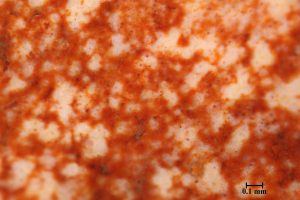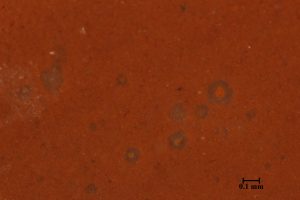05 Oct Raw material determination of chipped lithic artefacts
Raw material determination and determination of its origin is a specific part of the analysis of chipped lithic artefacts. The origins of the lithic raw material analysis are as old as the scientific research of this type of artefacts itself. The beginnings of really scientific methods in raw material determination based on a cooperation between archaeologists and geologists date back circa to the middle of the last century (Štelcl, Malina, 1975).
In the ERCA Centre, a method developed for analysis of lithic collections composed of many-thousand artefacts is used. Typical pieces of raw material are determined macroscopically, sometimes with a help of the hand magnifying glass. Doubtful artefacts are subsequently examined under the stereomicroscope, when it was in water beforehand, or water was applied on it as an immersion liquid (Přichystal, 2013). After the application of water, the raw material becomes at least partly transparent, enabling a description as to the colour, clarity of tarnishing of the silicite matter, inclusions, pigmentation, microfossils, possibly also embedded silicate minerals. On the grounds of this three-dimensional description, the artefact is compared to the raw materials from geological collecting localities deposited in the comparative collection (Přichystal, 2013, 43). This method enables the raw material determination in the case of vast majority of analysed artefacts.
I some specific cases, especially when a determination of exact raw material outcrop is wanted, we can apply some other petroarchaeological methods, such as petrographic thin sections analysis under the polarizing microscope, splinter method, examination of enclosed fluid inclusions in a case of the SiO2 minerals, magnetic susceptibility measurement by a portable kappameter (for a determination of weathering products of serpentinites containing magnetite grains) or a determination of trace elements and rare earths representation.
In the ERCA Centre the lithic analyses are guaranteed by Mgr. Ondřej Mlejnek, Ph.D., who in a case of the raw material determination cooperates with the geologists Prof. RNDr. Antonín Přichystal, DSc., and Mgr. Petr Gadas, PhD. From the Institute of Geologic Sciences at the Faculty of Sciences of the Masaryk university in Brno.
References:
Přichystal, A., 2013: Lithic Raw Materials in Prehistoric Times of Eastern Central Europe. Brno: Masaryk University.
Štelcl, J., Malina, J., 1975: Základy petroarcheologie. Brno: Univerzita J. E. Purkyně.

Jasper found at the Early Mesolithic site of Městec/Ostrov near Uhersko in eastern Bohemia. Photo in a water immersion under the stereomicroscope by A. Přichystal.

Radiolarite of the Szentgál type found at the Early Mesolithic site of Městec/Ostrov near Uhersko in eastern Bohemia. Photo in a water immersion under the stereomicroscope by A. Přichystal.





